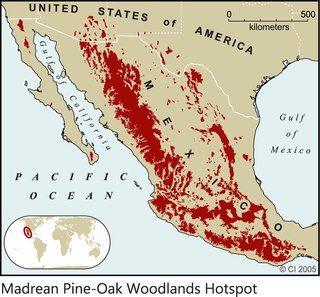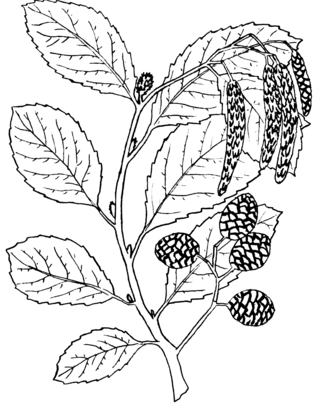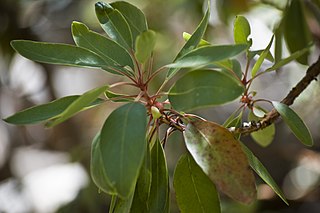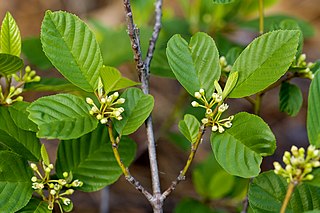
Pinus arizonica, commonly known as the Arizona pine, is a medium-sized pine in northern Mexico, southeast Arizona, southwest New Mexico, and western Texas in the United States. It is a tree growing to 25–35 m tall, with a trunk diameter of up to 1.2 m. The needles are in bundles of 3, 4, or 5, with 5-needle fascicles being the most prevalent. This variability may be a sign of hybridization with the closely related ponderosa pine. The cones are single, paired, or in whorls of three, and 5–11 cm long.

The Sierra Madre Occidental is a major mountain range system of the North American Cordillera, that runs northwest–southeast through northwestern and western Mexico, and along the Gulf of California. The Sierra Madre is part of the American Cordillera, a chain of mountain ranges (cordillera) that consist of an almost continuous sequence that form the western "sounds" of North America, Central America, South America, and West Antarctica.

The Madrean pine–oak woodlands are subtropical woodlands found in the mountains of Mexico and the southwestern United States. They are a biogeographic region of the tropical and subtropical coniferous forests and temperate broadleaf and mixed forests biomes, located in North America.

The Sierra Madre Occidental pine–oak forests are a Temperate broadleaf and mixed forests ecoregion of the Sierra Madre Occidental range from the southwest USA region to the western part of Mexico. They are home to a large number of endemic plants and important habitat for wildlife.

Alnus oblongifolia is a large alder growing up to 72 feet (22 m), from the southwestern United States and northern Sonora, Mexico. It grows across Arizona into western New Mexico mountain ranges. In central Arizona its range extends across the transition zone to the White Mountains region of eastern Arizona–western New Mexico border.

The narrow-skulled pocket mouse is a species of rodent in the family Heteromyidae. It is endemic to western Mexico, living west of the Sierra Madre Occidental crest.

Quercus albocincta is a species of oak tree. It is native to the Sierra Madre Occidental of western Mexico, in the states of Sonora, Chihuahua, Durango, and Sinaloa. It has also been found in the southernmost part of Baja California Sur.

Arbutus arizonica, commonly known as Arizona madrone, is a tree species in the heath family that is native to the southwestern United States and northwestern Mexico. Its range extends along the Sierra Madre Occidental cordillera from the Madrean Sky Islands of southeastern Arizona and southwestern New Mexico south as far as Jalisco. It has been found in Sonora, Chihuahua, Durango, and Sinaloa, with one isolated population in Tamaulipas.

Salix taxifolia, the yewleaf or yew-leaf willow, is a species of willow native to all of southern Mexico, also Pacific Coast regions, north to Sinaloa, and in the south Pacific Coast of Mexico into central Guatemala. Scattered populations are also reported from northern Mexico and from the US states of Texas, New Mexico, and Arizona.

Salix bonplandiana, , is a perennial species of willow tree native to southern and southwest Mexico and extending into central Guatemala; in western Mexico it is a tree of the Sierra Madre Occidental cordillera, but also occurring in other small locales, for example Baja California Sur, northern Sonora, San Luis Potosi, etc. A core disjunct area occurs in central and southeast Arizona, in advantageous locales, especially associated with higher elevations and water.

Platanus wrightii, the Arizona sycamore, is a sycamore tree native to Arizona and New Mexico with its range extending south into the Mexican states of Sonora, Chihuahua, and Sinaloa.

Frangula betulifolia, the birchleaf buckthorn, is a shrub or small tree in the buckthorn family, Rhamnaceae. It is native in northern Mexico in the Sierra Madre Occidental cordillera, and mountainous, desert regions of the Southwestern United States of Arizona, Utah, New Mexico, and far west Texas; besides being found in Sonora, Chihuahua and Durango of the Occidental cordillera, a large species locale occurs to the east in Nuevo León.

Quercus tarahumara is a species of tree in the beech family. It grows in the Sierra Madre Occidental in the Mexican States of Chihuahua, Sonora, Durango, and Sinaloa. Some of the populations lie within the territory occupied by the Tarahumara people, after whom the species is named. It is placed in Quercus section Lobatae.
Quercus viminea, the Sonoran oak, or Mexican willow oak, is a North American species of oak. It is native to northwestern and west-central Mexico, primarily in the Sierra Madre Occidental. The species range extends just north of the international border into Santa Cruz County in southern Arizona.
Quercus tuberculata is a species of oak tree which is native to mountains of northeastern and northwestern Mexico. It is placed in Quercus section Quercus.

The Chínipas is river of northwestern Mexico. The Chinipas arises deep in the Sierra Madre Occidental in the state of Chihuahua, and then flows through long rugged canyon systems into the state of Sinaloa until it finally joins the main trunk of the Fuerte River in the western foothills of the Sierra Madre Occidental. The Fuerte River then flows westward over the western coastal plain of Sonora to the Pacific Ocean, emerging very near the port of Topolobampo.

The Sierra de Álamos–Río Cuchujaqui Flora and Fauna Protection Area, also known as the Sierra de Álamos–Río Cuchujaqui Biosphere Reserve, is a protected area and biosphere reserve in western Mexico. It is located in southeastern Sonora state, along the boundary with Sinaloa and Chihuahua states.
Quercus mcvaughii is a species of oak tree native to Mexico.

Quercus jonesii is a species of oak tree native to Mexico. It is commonly known as palo manzano. It is placed in Quercus section Lobatae.

The Espinazo del Diablo is a region of the Sierra Madre Occidental in the states of Sinaloa and Durango in northwestern Mexico. The region is known its natural beauty and biodiversity, including rare cloud forests, and for a stretch tortuous mountain highway also called the Espinazo del Diablo.

















